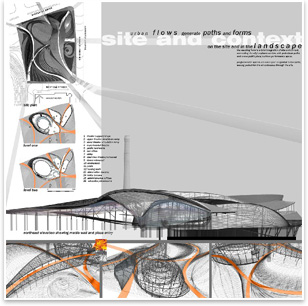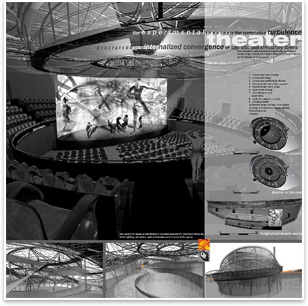
| Minimum Path Through a Field of Potential Summary: Deconstructing the collective developmental patterns of Chattanooga, Adam Gumowski, Assoc. AIA; Keith Van de Riet; and Stephen Mueller created form for their theoretical downtown cultural center. Following is a team design statement. Chattanooga has been developed and distorted as a response to cultural forces. The movement of people and the flux of expanding commerce along the Tennessee River provided the initial generative urban force, with the city becoming dense in an area tangential to one of its curves. The introduction of the orthogonal street grid, the onset of developing industry, and the incision of the highway system imposed new forces on this area, further distorting the city form.
These new centers are connected by a series of paths entering and leaving the site. These paths delineate urban forces that generate forms on the entire site. The forces diverge around the smokestack, the permanent object that generates turbulence in their flow.
The interdependence of the various surfaces resulted in the complete integration of site and context with building form. The site became a confluence of the cultural forces, with the Experimental Performing Arts Center and a new urban plaza developing within the resultant turbulence.
Pedestrian movement along the paths is uninterrupted through the site. This maintains the functional aspect of each path as part of the larger urban circulation. Entry into the building form is tangential to the paths, delineating interior circulation and articulating interior space. The development of the public lobby and the generation of the experimental theater are direct results of these internalized forces.
|
||
Copyright 2007 The American Institute of Architects. All rights reserved. Home Page |
||
out there
down here
here to there
back to earth




